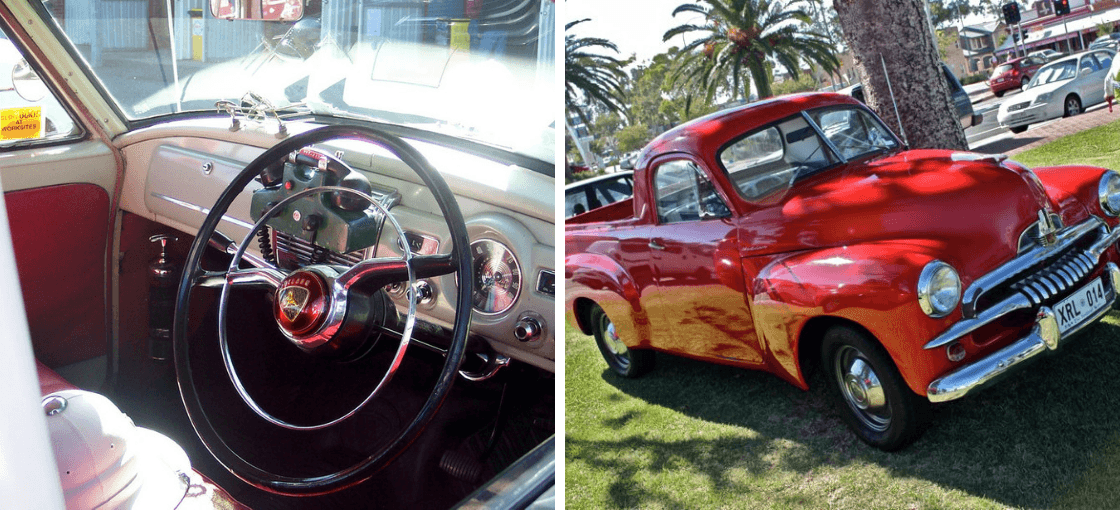Holden history: the F series

In our three part story about Holden (read part one Holden history: the early days), part two showcases Holden’s incredible F series.
The FJ Holden 1953–56
By 1953, the 48-215 (FX sedan) had certainly made its impression on Australia and was ready for an update. It was starting to look a bit dull compared with other makes and models on the road. Holden decided to give the FX a facelift and the FJ was born.
The most noticeable change was the front grill, which had been restyled into a beautiful finned version with a second bumper bar.
Other changes included cone-shaped hubcaps, new tyres, new bright metal body decorations, fins on the rear guards and a torpedo-style tail-light. Engine, power output and gearing remained unchanged. The FJ also had a much improved list of added options for the marketplace.
There were three model levels: Standard, Business and the Special sedan, the latter two levels included additional luxurious features. A panel van joined the utility to meet the needs of particular markets.
The FE Holden 1956–58
With the 1950s came a new design movement that swept into car manufacturing too. After eight years of the same shape and design, Holden was ready to rework its star car. The refresh came in the form of the FE Holden, which took it’s styling cues from the wildly popular American Chevrolets.
Compared with its predecessor (the FJ), the FE had a larger body, roomier interior, longer wheel base, wider track, lower roof, larger rear window and flatter bonnet. It also included a recirculating ball steering box, 12-volt electrical system, front stabiliser bar, wider wheel rims, a one piece rounded windscreen and pendant type pedals.
The new windscreen and larger rear window resulted in around a 40% increase in visibility. This coupled with smaller wheels and the other changes resulted in a car that handled much better than its predecessors and was much safer on the road.
While it was much more modern looking than the FJ, the only significant mechanical upgrades were to engine power and brakes. The FE’s engine sported bigger valves and slightly higher compression, which resulted in a 10% increase in power (53kw in the FE compared with 45kw in the FJ).
The FE also came with new colour schemes and models for personalisation, coupled with redesigned seating and better sound insulation. The dash was completely redesigned with a large centre-mounted radio speaker grille. Options on the FE included windscreen washers, reversing lights and a de-mister.
The FE Holden was released in Standard, Business, Special and Commercial (Ute and Panel Van). A Station Sedan/Wagon version entered production in early 1957.
The FC Holden 1958–59
Released in May 1958, the FC Holden was a facelift for the FE Holden. Changes included a larger grille that included parking lights, bolder vertical and horizontal bars, increased body decoration, improved interior trim and a new radio and speaker grille.
Engine capacity did not increased in the FC but a new camshaft gave the car more torque. The engine had an improved compression ratio that resulted in slightly more power. There were minor improvements to the suspension, brakes, gear change linkages and steering box.
The FC Holden was released in the types of Standard, Business, Special and Commercial (Ute and Panel Van).
The FB Holden 1960–61
Due to the popularity of Chevrolet-styled cars with the Australian public, Holden decided to continue with the same design for their new FB series.
Some refinements were made for this version including a length increase of 140mm and a new 138ci motor. The FB also featured new acrylic paint work (or ‘Magic Mirror’ as it was referred to at the time). This gave the FB an improved appearance over its predecessors.
Other changes included an American styled dash, upgraded brakes, fins that were part of the body, a roomier interior, better ventilation, a wrap-around windscreen (improving visibility by 30%), rear pillar windows, a lower bonnet line, brakes/suspension upgrades, heavier front coils and wider rear leaf springs. Also added was the new ‘Warmaride’ heater/de-mister and an optional wireless radio.
The FB was significant as it was the first Holden to be made with a left-hand drive variant for export. It was released in the types of Standard and Special.
Win!
You could win a powerful and sporty Holden Maloo in Cars for Cancer lottery No. 77! Don’t miss out on this opportunity to own this genuine Aussie automotive icon.
